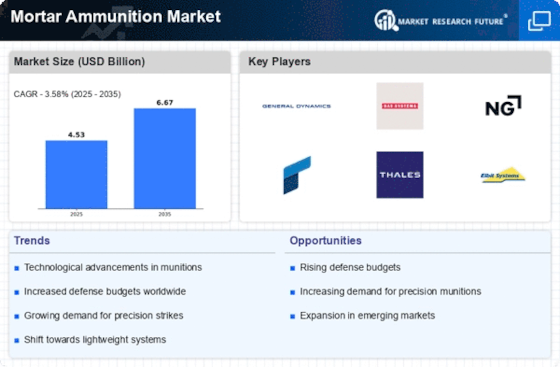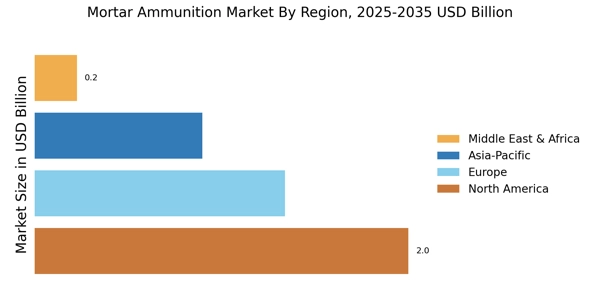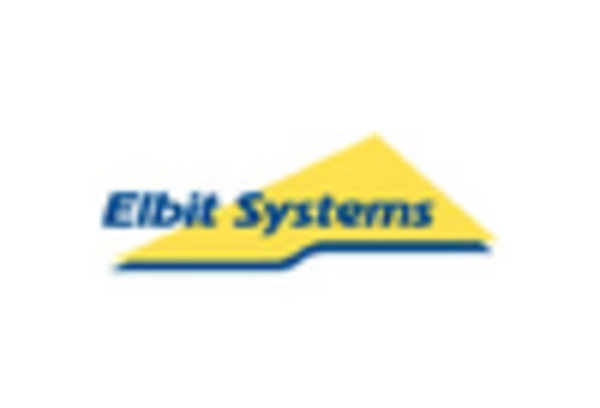Focus on Joint Operations
The Mortar Ammunition Market is witnessing a shift towards joint operations among military forces. This trend emphasizes the need for interoperability between different branches of the armed forces, which in turn drives the demand for standardized mortar ammunition. As military strategies evolve to incorporate joint exercises and operations, the requirement for compatible and versatile mortar systems becomes paramount. This focus on joint operations is likely to lead to increased procurement of mortar ammunition that can be utilized across various platforms and units. Furthermore, collaborative training exercises are fostering a greater understanding of mortar capabilities, thereby enhancing the overall effectiveness of joint military operations. The emphasis on joint operations is expected to sustain the growth of the mortar ammunition market.
Increased Defense Budgets
The Mortar Ammunition Market is significantly influenced by the rising defense budgets across various nations. Governments are allocating larger portions of their budgets to enhance military capabilities, which includes the procurement of advanced mortar ammunition. For instance, recent data indicates that several countries have increased their defense spending by over 5% annually, with a substantial focus on artillery and indirect fire systems. This trend is driven by geopolitical tensions and the need for enhanced national security. Consequently, the demand for mortar ammunition is expected to grow as military forces seek to modernize their arsenals. The increased financial commitment to defense is likely to create a favorable environment for manufacturers in the mortar ammunition sector.
Rising Asymmetric Warfare
The Mortar Ammunition Market is increasingly shaped by the rise of asymmetric warfare, where conventional forces face non-state actors and insurgent groups. This type of warfare often necessitates the use of indirect fire support, making mortar ammunition a critical component of military strategy. The adaptability and effectiveness of mortars in urban and irregular combat scenarios are driving demand. As military forces engage in counterinsurgency operations, the need for portable and versatile mortar systems becomes evident. Recent assessments suggest that the demand for lightweight and easily deployable mortar ammunition is likely to increase, as forces seek to enhance their operational flexibility. The ongoing prevalence of asymmetric threats is expected to sustain interest in mortar ammunition solutions.
Geopolitical Tensions and Conflicts
The Mortar Ammunition Market is significantly impacted by ongoing geopolitical tensions and conflicts around the world. As nations face threats from both state and non-state actors, the demand for effective artillery systems, including mortar ammunition, is on the rise. Recent conflicts have highlighted the importance of maintaining a robust supply of mortar rounds to support ground operations. Countries are increasingly investing in their military capabilities to deter potential aggressors, which includes the enhancement of their mortar systems. This geopolitical landscape is likely to drive sustained growth in the mortar ammunition market, as nations prioritize the readiness and modernization of their armed forces. The interplay between international relations and military preparedness is expected to shape the future of the mortar ammunition industry.
Technological Advancements in Mortar Ammunition
The Mortar Ammunition Market is experiencing a notable transformation due to rapid technological advancements. Innovations in precision-guided munitions and smart mortar systems are enhancing the effectiveness and accuracy of mortar ammunition. These advancements are not only improving operational capabilities but also reducing collateral damage, which is increasingly important in modern warfare. The integration of advanced materials and manufacturing techniques is expected to lead to lighter and more durable mortar rounds. Furthermore, the development of digital fire control systems is facilitating real-time targeting and coordination, thereby increasing the efficiency of mortar units. As a result, the demand for technologically advanced mortar ammunition is likely to rise, reflecting a shift towards more sophisticated military capabilities.


















Leave a Comment